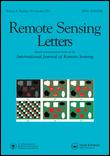 Remote Sensing Letters has retracted a 2015 paper by a pair of researchers in China because the duo was in fact a solo, and the manuscript lied about its funding source.
Remote Sensing Letters has retracted a 2015 paper by a pair of researchers in China because the duo was in fact a solo, and the manuscript lied about its funding source.
The article, “A novel method of feature extraction and fusion and its application in satellite images classification,” purportedly was written by Da Lin and Xin Xu, of Wuhan University. But as the retraction notice makes clear, that wasn’t the case:
The Editors and Taylor & Francis, publishers, of Remote Sensing Letters are retracting the following article:
Da Lin and Xin Xu (2015). A novel method of feature extraction and fusion and its application in satellite images classification. Remote Sensing Letters, Vol. 6, No. 9, 687–696. DOI: 10.1080/2150704X.2015.1062156Subsequent to publication, it has been determined that X. Xu was not aware that his name had been included by D. Lin as a co-author on this article, nor had he any other association with or responsibility for this article, which was solely authored and submitted by D. Lin. In addition, the research was not supported by either of the grants mentioned in the following Funding section:
Funding
This work was supported in part by the National Basic Research Program of China (973 Program) [grant number 2011CB707102] and the National High Technology Research and Development Program of China (863 Program) [grant number 2013AA122301].
The Editors of Remote Sensing Letters, and Taylor & Francis, publishers, censure this conduct, and as a result have decided to retract the article from publication.
The Editors of Remote Sensing Letters and Taylor & Francis, publishers, note we received, peer-reviewed, accepted, and published the article in good faith based on these warranties.
The paper has not been cited by Thomson Reuters Web of Science.
What’s particularly interesting about this retraction is that Xu, who claims to have had nothing to do with the paper, is listed as the corresponding author. The email address on the paper appears on other publications Xu co-authored without Lin. (However, when we tried contacting Xu using that address, we got an error message saying the email couldn’t be delivered.) So we’re wondering how the journal corresponded with an author during the review and publication process, if Xu wasn’t involved.
Da Lin and Xin Xu, who work at the same institution, appear to have collaborated before. For example, their names show up on a 2015 meeting poster and a 2015 paper in the Canadian Journal of Remote Sensing. This paper shares some similarities with the retracted paper; consider the abstract from the retracted article:
Diverse and complementary feature descriptors extracted from the same satellite scene always reflect different characteristics of data. Consequently, it is worthwhile to implement the extraction and fusion on multiple feature descriptors. In this letter, we resolve the problem of multiset correlation feature extraction and fusion in multiple feature descriptors. To this end, a new approach is suggested to perform multiset correlation feature extraction and fusion for classification named global geometric multiset canonical correlation analysis (GGMCCA), which couples global geometric nature of data in the transformed space of low dimensionality and correlational characteristics of any pair of feature sets. In this regard, GGMCCA possesses superiority in discriminant capability in contrast to a previous approach named multiset integrated canonical correlation analysis (MICCA), which merely takes correlations into account for classification. Extensive experimental results on the satellite scenes demonstrate that GGMCCA surpasses multiset canonical correlation analysis and MICCA in computational efficiency and classification accuracy.
And the abstract from the paper in the Canadian Journal of Remote Sensing:
Different and complementary features extracted from the same satellite image always reflect distinct characteristics of the data. As a consequence, it is worthwhile to implement the fusion on multiple features. In this study, we solve the problem of fusion in multiple features for satellite image classification. To this end, a new method named label propagation-based semisupervised canonical correlation analysis (LPS2-CCA) is suggested, which incorporates a new, sparse, representation-based label propagation algorithm to infer label information of unlabeled data. In this regard, LPS2-CCA possesses superiority in discriminant capability in contrast to many existing related methods that cannot take full advantage of given label information for classification. Extensive experimental results on the satellite images demonstrate that the suggested method can obtain better classification performances and robustness compared with existing related methods.
We emailed Xu for comment.
Giles Foody, editor of Remote Sensing Letters, declined to provide us with more information:
I do not feel comfortable discussing the matter, it is complex and challenging topic … I’d rather focus on the work from excellent colleagues who contribute to the journal as authors, referees and or editors etc.
Like Retraction Watch? Consider making a tax-deductible contribution to support our growth. You can also follow us on Twitter, like us on Facebook, add us to your RSS reader, sign up on our homepage for an email every time there’s a new post, or subscribe to our new daily digest. Click here to review our Comments Policy.